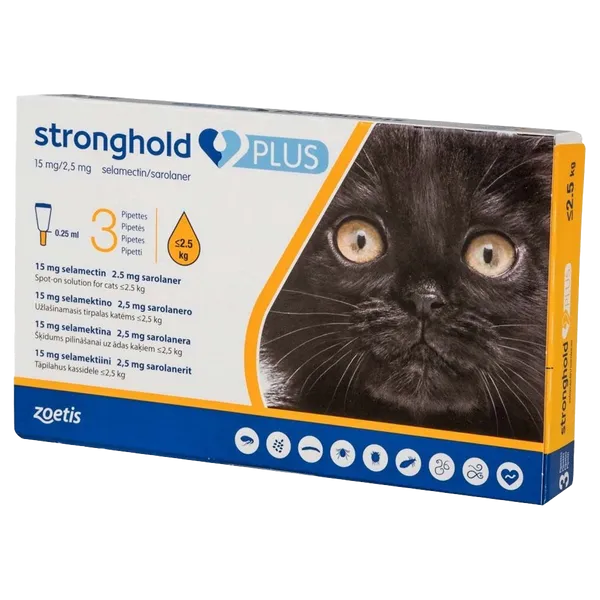Contraindications:
- Do not use in cases of hypersensitivity to the active substances (selamectin, sarolaner) or to any of the excipients.
- Do not use in cats that are suffering from concomitant disease, or are debilitated and underweight (for size and age).
Special Warnings:
- It is recommended that all animals 6 months of age or more, living in countries where heartworm vector exists, should be tested for existing adult heartworm infections before starting preventive use.
- This veterinary medicinal product is not effective against adult D. immitis.
- Ticks need to start feeding on the host to become exposed to sarolaner; therefore, transmission of infectious tick-borne diseases cannot be excluded.
- The efficacy has not been established in cats with severe clinical signs of N. cati.
- This product is for external application to the skin surface only. Do not administer orally or parenterally.
- If significant ingestion occurs, transient gastrointestinal effects such as hypersalivation, emesis, soft faeces or reduced food consumption may be observed, which should normally resolve without treatment.
Overdose:
No clinically significant adverse reactions were observed in kittens from 8 weeks of age treated with up to 5 times the maximum recommended dose for up to 8 consecutive treatments at 28-day intervals, apart from a single cat administered 5 times the maximum dose that displayed transient hypersensitivity to touch, piloerection, mydriasis and mild tremor which resolved without treatment. After accidental ingestion of a full product dose, transient gastrointestinal effects such as salivation, soft faeces, emesis, and reduced food consumption may occur; however, these should resolve without treatment.
Adverse Events (Cats):
- Uncommon (1 to 10 animals / 1,000 treated): Application site pruritus (itching), application site alopecia (hair loss), erythema (redness), drooling.
- Very Rare (<1 animal / 10,000 treated): Convulsions, ataxia (incoordination), vomiting, diarrhoea.
Special Precautions for Persons Administering the Product:
- The veterinary medicinal product is harmful after ingestion. Keep in original packaging until use to prevent children from direct access.
- Used pipettes should be disposed of immediately. In case of accidental ingestion, seek medical advice immediately and show the package leaflet.
- The product may cause eye irritation. Avoid eye contact, including hand-to-eye-contact.
- Avoid direct contact with treated animals until the application area is dry.
- Wash hands after use and wash off any product in contact with the skin immediately with soap and water.
- In case of accidental eye exposure, flush eyes immediately with water, seek medical advice immediately and show the package leaflet.
- People with sensitive skin or known allergy to veterinary medicinal products of this type should handle with caution.
- The veterinary medicinal product is highly flammable. Keep away from heat, sparks, open flame or other sources of ignition.
- Children are not allowed to play with treated cats for 4 hours after treatment.
- It is recommended to treat animals in the evening. On the day of treatment, treated animals should not be permitted to sleep in the same bed as their owner, especially children.
Pregnancy, Lactation and Fertility:
The safety of the veterinary medicinal product has not been established during pregnancy and lactation or in animals intended for breeding. Use only according to the benefit-risk assessment by the responsible veterinarian.
Disposal:
Medicines should not be disposed of via wastewater. The veterinary medicinal product should not enter water courses as this may be dangerous for fish and other aquatic organisms. Dispose of containers and residual contents along with collected domestic refuse to avoid contamination. Ask your veterinary surgeon or pharmacist how to dispose of medicines no longer required. Dispose of unused veterinary medicinal product and waste materials in accordance with local requirements.

